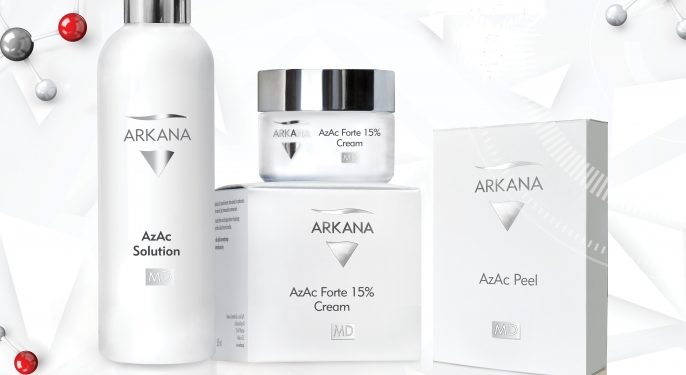
Proper care of skin prone to acne vulgaris or rosacea can be tricky. Arkana’s R&D Department has addressed the challenge posed by the needs of such skin by developing the novel AzAc Therapy Arkana MD. The line’s key active ingredients are azelaic acid and its derivative, azeloglycine, both of which are target the main underlying causes of acne lesion formation and aggravation. So, how does azelaic acid work? What are its top 3 benefits?
- IT IS SUITABLE FOR YEAR-ROUND USE
Azelaic acid (AzA) is superior to multiple other acids employed in the cosmetic industry, as it is suitable for use throughout the year. It is especially recommended for skin with poor tolerance of retinol products. Moreover, it works wonders tackling issues such as skin aging , photo-aging, and skin discolouration, and counteracts excessive horny epidermis buildup, thus also preventing comedones from forming and pores from clogging up. It inhibits the growth of bacteria conducive to acne lesions, and downregulates sebum production by the sebaceous glands. Also, it restores a normal pH level, and reduces the free fatty acid content in the lipid coat. All in all, due to all these courses of action combined, it renders the skin a less favourable environment for pathological microbial growth.
- IT HAS ANTI-INFLAMMATORY AND ANTI-OXIDANT PROPERTIES
One of the key characteristics of azelaic acid is its anti-inflammatory and anti-oxidant capability that, combined with the anti-bacterial and sebum-regulating potency discussed above, renders it so effective in tackling these particular skin problems. These were the properties that led the American Food and Drug Agency as early as in 2002 to approve and recommend it for treatment of rosacea.
- IT BRIGHTENS AND PREVENTS SKIN DISCOLOURATION
Yet another hallmark of azelaic acid is its ability to brighten and prevent skin discolouration. Importantly, it is selective in its action, only brightening specific discolouration, while not affecting the normally coloured skin. For skin marked with post-inflammatory and post-traumatic discolouration, this truly is a godsend.
Azeloglycine – the “extra something special”
The effects of AzAc Therapy MD line products are enhanced by the addition of azeloglycine, which is also based on azelaic acid. The acid’s particle is modified and joined to glycine amino acid, making it mild and well-tolerated by skin that is sensitive or prone to breaking and dilated capillaries. Azeloglycine also boosts the skin’s hydration and elasticity, thereby strengthening its protective barrier. This is important especially for skin vulnerable to the damage rendered by the inflammatory process involved in the formation of acne lesions.
How is AzAc Peel treatment performed?
Before AzAc Peel procedure may be applied to the skin, a detailed skin diagnostics is performed by a cosmetologist, who also tests very sensitive skin for its tolerance of the product. The amount of the formulation to be used for the treatment, and the time of its application are matched very carefully to the skin’s condition.
The procedure itself is a two-step one. First, a solution containing 16% of azelaic acid combined with 10% of mandelic and 2% of salicylic acid is applied to the skin, and next, a gel with 16% of azelaic acid. The skin may respond in a variety of ways, including redness, tingling, itching, or burning, all of which are normal, and last no longer than for an hour. The formulation is left on the skin for 6-8 hours, depending on the recommendation of the cosmetologist, based on the skin’s type and its response. Upon this time, the peel should be rinsed off with lukewarm water, and Post Treat Gel applied to the treated skin.
It is important to mention that for best, enhanced results, proper home-based skin care is vital. Within the first days after the treatment, calming products from Post Treat Therapy Line are recommended. On the 3rd day following the procedure, dermo-cosmetics with azelaic acid and azeloglycine should be introduced, including the specialist AzAc Solution and AzAc Forte 15% Cream.
What will the skin look like immediately after the treatment?
The peel’s cleansing action may cause tiny papules or pustules to form on the skin after 2-3 days from the procedure, that later spontaneously resolve. Within several days following the treatment, the skin may also feel dry and scaly. Later, it becomes visibly clearer, purer, and acquires a healthy glow and brighter appearance. Any discolouration is visibly less pronounced, and skin pores are attenuated.

